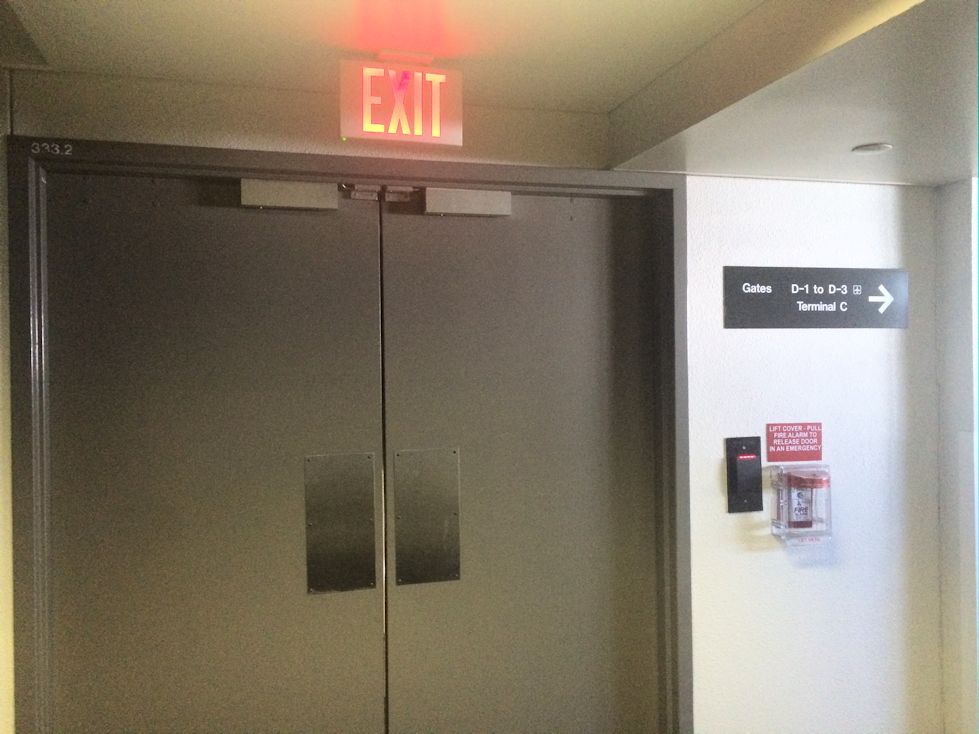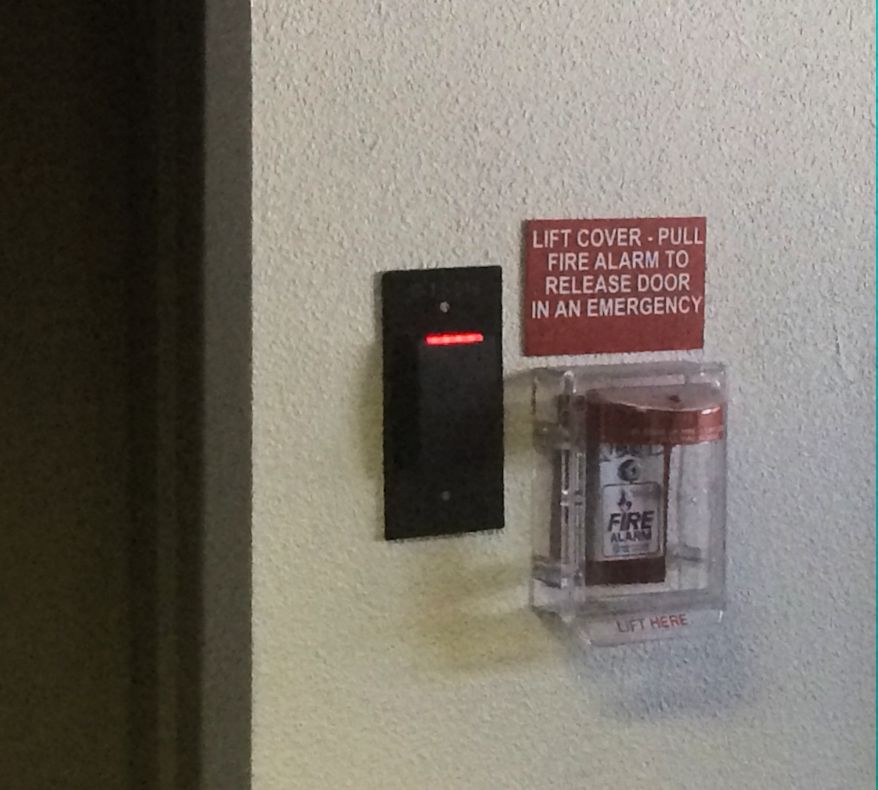I posted these photos (below) yesterday to ask what problems you all saw. Here’s what I see…
- We will assume that these are not fire doors – if they were fire doors they would require latching hardware.
- These doors are serving as part of the means of egress for the airport terminal – an Assembly occupancy. Both the IBC and NFPA 101 define facilities used for “awaiting transportation” as an Assembly occupancy (Use Group A-3 for the IBC). The occupant load of an airport terminal is typically very large – much greater than 50 or 100 occupants. Therefore, these doors would require panic hardware because doors equipped with a lock or latch serving an Assembly occupancy with a load of 50+ (IBC) or 100+ (NFPA 101) must be equipped with panic hardware. I wrote about using mag-locks in lieu of panic hardware a while back (click here to review) – most code officials do not allow mag-locks without panic hardware for doors serving Assembly occupancies.
- The doors are equipped with mag-locks and they do not appear to be delayed egress mag-locks. Assuming that they are standard mag-locks, this application is covered by the section of the IBC now called Sensor Release of Electrically Locked Egress Doors. Prior to the 2015 edition of the IBC, and also in NFPA 101 (including the 2015 edition), this section is called Access Controlled Egress Doors. The model codes require mag-locks in this configuration to be released by a sensor that detects an approaching occupant, activation of the fire alarm system, power failure, and a push-button beside the door – with signage – which unlocks the door for 30 seconds independent of the access control system. Ready access must be provided to the push button. I don’t see a sensor here, and I don’t think a fire alarm pull station meets the prescriptive requirements of the model codes regarding the push button.
- There is another section of the model codes that can be used for doors with mag-locks instead of the section mentioned above, but this section applies to mag-locks which are released by door-mounted hardware, like panic hardware with a request-to-exit switch. This code section (called Electromagnetically Locked Egress Doors in the IBC, and Electrically Controlled Egress Door Assemblies in NFPA 101), does not require the mag-locks to unlock upon activation of the fire alarm system, but this section would not apply to this pair of doors because the mag-locks are not released by door-mounted hardware.
- As one of yesterday’s commenters pointed out, doors in airports are subject to the rules of the Department of Homeland Security (DHS). BUT…when I spoke to someone “in the know” with regard to airport design and code requirements, he told me that his office (design department for an airport) is still required to submit the typical paperwork with their local code officials in order to get approval for modifications to the local code – even when those modifications are mandated by the DHS.
- On the doors below, I would typically expect to see delayed egress locks. This would still require a modification of the code, since delayed egress locks aren’t allowed by the IBC for doors serving Assembly occupancies (or Educational, or High Hazard). But I think a modification for a delayed egress lock might be a little easier to accept than a modification for standard mag-locks released by a fire alarm pull station. Just my opinion.
You need to login or register to bookmark/favorite this content.







It seems the more people try to clean up the codes, the muddier they get sometimes.
1. http://idighardware.com/2012/02/locksmith-ledger-code-requirements-for-electromagnetic-locks/
2. I thought a few moons ago Von Duprin had a listed system that was panic hardware, and released electromagnetic locks??? No delay?
3. I kind of do not understand why an electronic touch bar cannot be used in place of panic hardware to release an electromagnetic lock??? Maybe a test and listing is needed?
4. On the airport question, one solution is is the exit acutally needed?? Can the exit sign be removed/
Just an aside, the sign with directions for using the pull station appears to be tactile. It is not required to be tactile and should not be as it is not an exit sign or room/space identifier. Additionally as it is located in the position specified for exits and room identification signs, a blind person could injure themselves trying to read the tactile sign over the pull station and a person who reads braille could be totally confused if they believed it was a room identifier or exit sign. Not to mention it interferes with the operation of the operable part. Very poor choice of location and signage.
Thanks Rick!
Lori I always learn something from your posts so thank you for your website. These actually do appear to be Delayed Egress, if you look closely at the mag locks, the left underside of each Mag lock shows the edge of a mortise cylinder. Although you may find a modified mag lock with a keyed cylinder switch, I’m not aware of a market purchased mag lock that would have a keyed cylinder on it that wasn’t used for Delayed Egress thus I would be pretty confident these are Delayed Egress. You make a great point on if this is an Assembly area, and it may be which of course would be an issue. It could also be in an area that is carrying a different classification, although unlikely. Missing, if this actually is a delayed egress opening, is a sign indicating that an alarm will sound and doors will release after 15 seconds. It would appear that they are using the Mag Lock’s rocker switch (if this is delayed egress). If this isn’t delayed egress, they would be missing a motion sensor to release from egress side along with an emergency push button located within 5 ft of the opening to release doors for a minimum of 30 seconds, independent from the Access Control System (although I can see a variance would likely be accepted to have the fire alarm pull station act as this second or emergency release switch…the only potential issue with this is that this switch is not directly cutting power to mag lock, but cutting power through another system’s relay). I’ve been told by a number of AHJ’s that Mag locks must be tied to the building fire alarm, sprinkler, and/or fire detection, evac systems even though the opening may not be a fire rated opening and are to remain unlocked until system is reset…see IBC 1008.1.3.4 (Access Controlled egress doors).
Hi Gary –
I held off on responding to your comment because I knew that I would be passing through the same airport again. I could not get to these exact doors, but there are doors with this set-up all over the airport. I looked closely at some other sets of doors with the same fire alarm pull stations, mag-locks, and signage, and I didn’t find any delayed egress mag-locks. I’m sure that the system they have in place have been approved by the local AHJ, but I’m not a fan of using the pull station to unlock the doors. I think most “civilians” would be very hesitant to do that.
– Lori